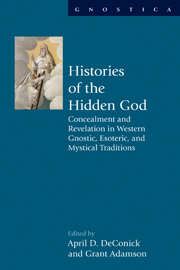 Histories of the Hidden God
Histories of the Hidden God Book contents
- Frontmatter
- Contents
- Acknowledgments
- Contributors
- Introduction: In search of the hidden God
- Part I Concealment of the Hidden God
- Part II The Human Quest for the Hidden God
- Part III Revelations of the Hidden God
- 11 Revealing and concealing God in ancient synagogue art
- 12 The invisible Christian God in Christian art
- 13 On the Mothman, God, and other monsters: The demonology of John A. Keel
- 14 Hidden away: Esotericism and Gnosticism in Elijah Muhammad's Nation of Islam
- 15 Conscious concealment: The repression and expression of African American Spiritualists
- 16 Occulture in the academy? The case of Joseph P. Farrell
- Afterword: Mysticism, Gnosticism, and esotericism as entangled discourses
- Bibliography
- Index
11 - Revealing and concealing God in ancient synagogue art
from Part III - Revelations of the Hidden God
- Frontmatter
- Contents
- Acknowledgments
- Contributors
- Introduction: In search of the hidden God
- Part I Concealment of the Hidden God
- Part II The Human Quest for the Hidden God
- Part III Revelations of the Hidden God
- 11 Revealing and concealing God in ancient synagogue art
- 12 The invisible Christian God in Christian art
- 13 On the Mothman, God, and other monsters: The demonology of John A. Keel
- 14 Hidden away: Esotericism and Gnosticism in Elijah Muhammad's Nation of Islam
- 15 Conscious concealment: The repression and expression of African American Spiritualists
- 16 Occulture in the academy? The case of Joseph P. Farrell
- Afterword: Mysticism, Gnosticism, and esotericism as entangled discourses
- Bibliography
- Index
Summary
Jewish representations of the divinity in late antique synagogue art reflect a simultaneity of revelation and concealment that parallels Targumic interpretations of the human-divine encounter. The use of memra for the active divine principle, or logos, suggests a simultaneous aural immanence and visual hiddenness that synagogue artists expressed through their use of the manus dei. This visual syntax of coincidentia oppositorum uses a boundary or distinction between heavenly and earthly realms to distinguish the aspect of god that remained hidden to the viewer from that aspect of god which was revealed.
The synagogues of both third-century Dura Europos, Syria and sixth-century Palestine Beth Alpha in the Jezereel valley, offer visual representations of god in pars pro toto. This essay discusses the depiction of the hand of god in illustrations of the Akedah, the binding of Isaac, as described in Genesis 22 in light of Targumic interpretations and liturgical poetry. This study employs the “holistic” methodology adapted from Byzantine Christian art history by historian of Jewish art Steven Fine, who proposes interpreting synagogue art in its ritual context. This viewer-centered approach has the advantage of taking into account the polysemic quality of images while attempting to avoid the over-reading and eisegetical shortcomings of earlier scholarship.
- Type
- Chapter
- Information
- Histories of the Hidden GodConcealment and Revelation in Western Gnostic, Esoteric, and Mystical Traditions, pp. 205 - 216Publisher: Acumen PublishingPrint publication year: 2013


